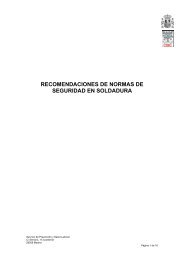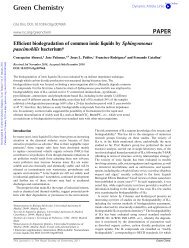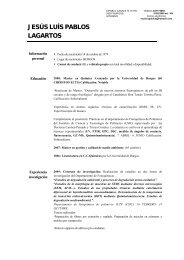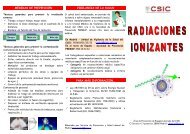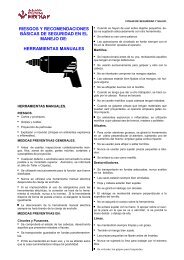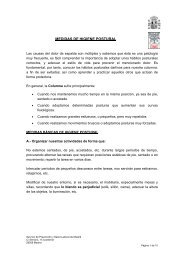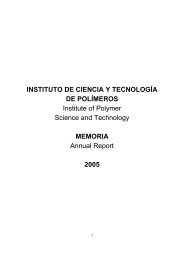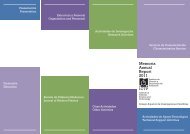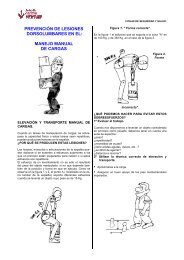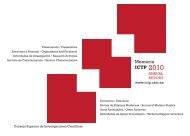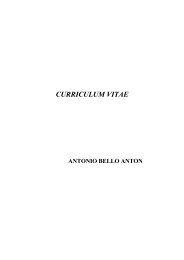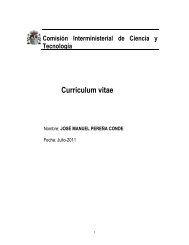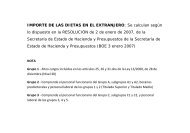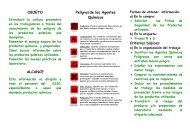Isolation and identification of bacteria and fungi from ... - ictp
Isolation and identification of bacteria and fungi from ... - ictp
Isolation and identification of bacteria and fungi from ... - ictp
- No tags were found...
You also want an ePaper? Increase the reach of your titles
YUMPU automatically turns print PDFs into web optimized ePapers that Google loves.
ARTICLE IN PRESS<br />
C. Abrusci et al. / International Biodeterioration & Biodegradation 56 (2005) 58–68 65<br />
Fig.3.Microsatellite primed PCR fingerprinting for A. alternata<br />
strains HB1 (lane 2) <strong>and</strong> HB41N (3); P. chrysogenum strains HLV1 (5),<br />
HMI (6), HGC3B (7), HGC1 (8), HB7 (9), HB6 (10) <strong>and</strong> HB41B (11);<br />
(4), (12) control, 100 bp ladder.<br />
oxygen availability.In a previous study (Abrusci et al.,<br />
2004c), it was stated that these gelatinase-positive<br />
<strong>bacteria</strong>l isolates can degrade photographic grade<br />
gelatin (Bloom 225) in aqueous solution (37 1C,<br />
6.67%, w/w) causing progressive viscosity decrease,<br />
with each species showing a characteristic viscosity<br />
decrease pr<strong>of</strong>ile, which changed with temperature.At<br />
4 1C, only B. amyloliquefaciens, B. subtilis, B. pumilus<br />
<strong>and</strong> B. megaterium were able to degrade gelatin aqueous<br />
solution.Nevertheless, in studies <strong>of</strong> several industrial<br />
gelatin production processes (De Clerck <strong>and</strong> De Vos,<br />
2002) <strong>and</strong> semi-final gelatin extracts (De Clerck et al.,<br />
2004), the authors reported that under experimental<br />
conditions the majority <strong>of</strong> isolates exhibited gelatinase<br />
activity.<br />
All filamentous <strong>fungi</strong> isolated in this work were able<br />
to degrade gelatin in the tube test (Table 2), but the<br />
yeast did not, although other strains <strong>of</strong> this species have<br />
been reported as proteolytic (Wade et al., 2003).Unlike<br />
yeasts, filamentous <strong>fungi</strong> are very important microbial<br />
Table 2<br />
Gelatinase activity <strong>of</strong> microbial strains (<strong>bacteria</strong> <strong>and</strong> <strong>fungi</strong>) isolated<br />
<strong>and</strong> identified <strong>from</strong> cinematographic films<br />
Strain Identification Gelatin hydrolysis<br />
been reported as soil <strong>and</strong> airborne <strong>fungi</strong>.The biodiversity<br />
in that research was therefore different <strong>from</strong> that in<br />
our investigation.It might be due to the higher climatic<br />
differences existing between the Spanish archives,<br />
especially if we consider that two <strong>of</strong> them are placed<br />
in coastal areas where environmental humidity is much<br />
higher than in Madrid.<br />
The only yeast isolated was identified as Cryptococcus<br />
albidus, which has been isolated <strong>from</strong> air, soils, <strong>and</strong> a<br />
range <strong>of</strong> habitats, as well as <strong>from</strong> man <strong>and</strong> other<br />
mammals (Barnett et al., 2000).Although in general<br />
terms yeasts cannot survive or develop in habitats with<br />
low water activity.However, it has been reported that C.<br />
albidus var. diffluens shows adaptation to extreme low<br />
humidity (water activity) (Aksenov et al., 1973).<br />
3.3. Gelatin microbial biodegradation tests<br />
In cinematographic films, gelatin degradation is a<br />
highly relevant problem, because it causes the loss <strong>of</strong> the<br />
image.Since some microbial contaminants found in our<br />
film samples were able to grow actively <strong>and</strong> produce<br />
severe deterioration <strong>of</strong> the films, the ability <strong>of</strong> all the<br />
microorganisms isolated <strong>from</strong> cinematographic films to<br />
degrade gelatin was checked. Table 2.Seven <strong>of</strong> the 14<br />
<strong>bacteria</strong>l isolates degraded gelatin in both Petri dish <strong>and</strong><br />
tube hydrolysis tests, six being Bacillus spp.In addition,<br />
S. lentus hydrolysed gelatin in the Petri dish assay, but<br />
not in gelatin test tube assay, perhaps owing to the lower<br />
B3BA Bacillus amyloliquefaciens +<br />
B7 Bacillus megaterium +<br />
GC2 Bacillus megaterium +<br />
M2 Bacillus pichinotyi +<br />
M5 Bacillus pumilus +<br />
B3BS Bacillus subtilis +<br />
M4 Kocuria kristinae<br />
GC1A Pasteurella haemolytica<br />
B4A Sphingomonas paucimobilis<br />
B2 Staphylococcus epidermidis<br />
M3 Staphylococcus haemolyticus<br />
B4C Staphylococcus hominis +<br />
B5 Staphylococcus lentus<br />
a<br />
GC1B Staphylococcus lugdunensis<br />
HB1 Alternaria alternata +<br />
HGC3 Aspergillus versicolor +<br />
HM3 Aspergillus nidulans var. nidulans +<br />
HB2 Aspergillus ustus +<br />
HGC2B Aspergillus ustus +<br />
HB3A Cladosporium cladosporioides +<br />
HM4 Mucor racemosus +<br />
HB41B Penicillium chrysogenum +<br />
HB41N Alternaria alternata +<br />
HB6 Penicillium chrysogenum +<br />
HB7 Penicillium chrysogenum +<br />
HMI Penicillium chrysogenum +<br />
HGC1 Penicillium chrysogenum +<br />
HGC3B Penicillium chrysogenum +<br />
HLV1 Penicillium chrysogenum +<br />
HGC3N Phoma glomerata +<br />
HGC2 Trichoderma longibrachiatum +<br />
LB6 Cryptococcus albidus<br />
+ ¼ positive;— ¼ negative.<br />
a Negative in tube-test but positive in Petri-dish assay.



